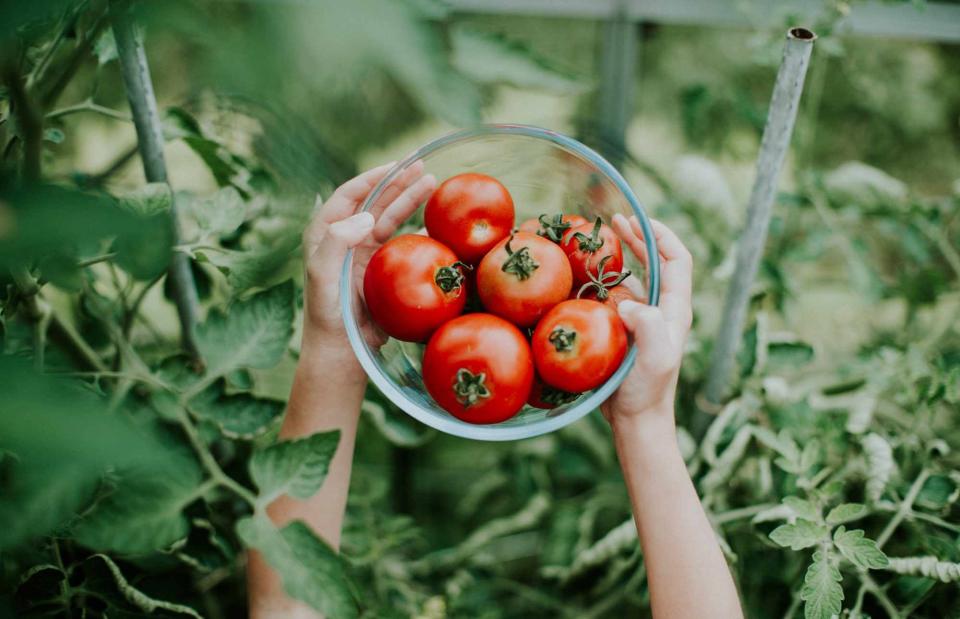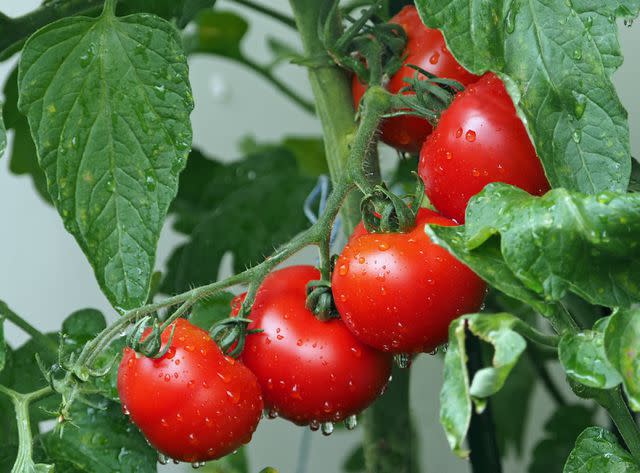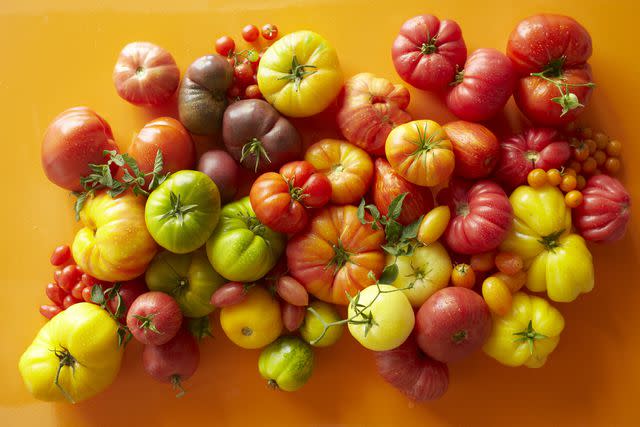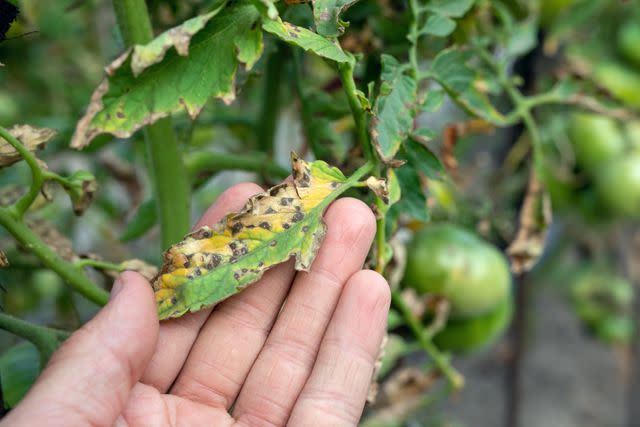How To Grow And Care For Tomatoes
Plant tomatoes in your backyard for a tasty slice of summer.

We're all for locally grown foods—and you can't get much more local than right outside your door. Even if you're short on space, a tiny, sunny patch of earth can become a productive planting bed for tomatoes. In the summer, there's nothing simpler or more delicious than a tomato sandwich served on white bread with a little mayo. Or a fresh pop of tomato in a leafy salad. Or an herb-infused sauce made with your own tomatoes. Step it up and make a BLT, or combine sliced tomatoes with fresh basil and mozzarella for a summer salad. The options are endless. No matter which tomato recipe you choose, home-grown tomatoes will always taste better. A reminder: Keep pets and small children away from the plants as the stems, leaves, and roots are toxic to animals and to people.
Plant Attributes
Common Name | Tomato, love apple |
Botanical Name | Solanum lycopersicum |
Family | Solanaceae |
Plant Type | Vegetable / fruit, annual, perennial |
Mature Size | 3-10 ft. tall, 1-4 ft. wide |
Sun Exposure | Full |
Soil Type | Well-drained but moist |
Soil pH | Mildly acidic (5.8-6.8) |
Hardiness Zones | 10-11 (USDA) |
Native Area | South America |
Toxicity | Stems, leaves, and roots toxic to pets, toxic to people |

erin1979/500px/Getty Images
Tomato Care
Tomato plants happily grow in sun-drenched, warm soil with good drainage. Provide consistent moisture and a side dressing of tomato fertilizer for the best-looking fruit. Most varieties naturally collapse and grow along the ground unless you provide good support in the form of a cage, trellis, or stake. Indeterminate varieties grow endlessly, sometimes reaching 10 feet tall, and should be planted 3 feet apart. Determinate varieties grow to a certain point and then stop. Make sure you choose the right variety for the space you have available, especially if you plan to grow yours in a container.
Planting Tomatoes
It's important to wait until the coldest weather has passed before planting tomatoes. Plant all tomatoes in the late spring or early summer after the potential for frost has passed. Some gardeners begin their seeds indoors prior to that time. You can plant seeds indoors up to four to six weeks before the last frost date and then transplant seedlings once warm weather arrives. They will be ready to transplant when they have multiple sets of leaves and have reached a height of 6 inches tall. Tomatoes should be planted deep in fertile, well-drained soil. You can bury up to 2/3 of the stem, removing any leaves that would be below ground. The stem will sprout new roots that result in a stronger plant.
Light
Plant your tomatoes in full sun, where they can receive at least six to eight hours of direct sunlight a day. Without adequate sunlight, your tomatoes will be fewer, smaller, and slower to ripen. If your garden falls a bit short on sun exposure, choose plants that bear smaller fruits, like cherry tomatoes. They won't be as prolific but should still produce fruit with three or four hours of direct sun.
Soil
Tomato plants perform best in mildly acidic and moderately moist soil. They like loamy soils but can grow in average garden soil as long as the soil is well-drained. They have been known to grow in clay but are not likely to thrive in heavy clay soils. Have your soil tested before the growing season begins and add the recommended amendments to bring your soil into a fertile balance. It is especially important to add lime if your soil is too acidic. Mix in 3 or 4 inches of compost when you plant to improve drainage in clay soil or help retain moisture in sandy soil. Even in loamy soils, compost will provide much-appreciated nutrients to the plants and help them better produce during harvest.
Water
Because tomatoes do best with consistent moisture, add 2 or 3 inches of bark mulch, straw, or shredded leaves around your plants. In the absence of rainfall, water tomatoes regularly, aiming for an inch of moisture per week and even more than that during hot, dry weather. Stick your finger in the dirt, and water if the top inch of the soil feels dry. Regular watering will help prevent your tomatoes from cracking, splitting, or developing blossom-end rot, which we discuss in more detail below. Tomato plants are susceptible to fungal diseases, so be careful not to get the foliage wet when watering.
Temperature And Humidity
Tomatoes are a warm-season fruit that grows slowly in cold soil and won't set fruit if nighttime temperatures are below 55 degrees. Don't plant until after the last frost of the season has passed, but at the same time, it's best to get your tomatoes in the ground early if you live in the South. The plants thrive when it is 70 to 80 degrees Fahrenheit during the day. Especially in high humidity, hot days above 85 degrees can prevent fruit from setting, often putting your harvest on pause until temperatures drop again.
If your soil temperature is under 60 degrees, you can still plant early to beat the heat. Cover the soil around your plants with clear plastic so that the sun warms the soil. Remove the plastic and replace it with mulch once temperatures rise.
Gardeners in the Coastal South (USDA Zone 9) can plant one tomato crop in late winter for an early summer harvest and one crop in late summer for a fall harvest. In the Tropical South, tomatoes are often grown as a fall and winter crop.
Fertilizer
Tomatoes are heavy feeders that benefit from fertilization. The best approach is to have your soil tested for recommendations specific to your garden. If you don't get your soil tested, choose a fertilizer formulated for tomatoes and other vegetables. These fertilizers have a lower nitrogen level, as too much nitrogen causes plants to produce lots of leafy, green growth instead of fruit.
Commercial tomato fertilizers usually contain calcium to help prevent blossom-end rot, an issue caused by a calcium deficiency in the fruit. This can be due to a lack of calcium in the soil or to inconsistent watering that interferes with the plant's uptake of calcium. As indicated by the name, the ends of the fruits begin to rot, rendering them inedible. While often seen in tomatoes, this issue can also afflict peppers, eggplants, and different kinds of squashes.
Fertilize when first transplanting your tomatoes, mixing the fertilizer well into the soil according to the directions on the label. When the first fruits appear, side-dress the plants with more fertilizer (usually 2-3 Tbsp. per plant). Some gardeners continue fertilizing every four to six weeks during the growing season, but this is weather-dependent—don't fertilize your plants during a heat wave.
Types Of Tomatoes

There are two major classifications of tomatoes: indeterminate, which continue growing throughout the season, and determinate, which stop growing at a certain point and tend to set fruit all at once. Determinate tomatoes are a better choice for growing in a container or small garden.
Choose from hybrids or heirlooms in a rainbow of colors—red, pink, black, orange, or yellow. For classic reds, try 'Big Boy,' 'Better Boy,' and 'Celebrity.' For pinks, pick 'Arkansas Traveler,' 'Pink Girl,' and 'Watermelon Beefsteak.' Black selections offer some of the most flavorful tomatoes. Try 'Black Krim' or 'Cherokee Purple.' Orange ones such as 'Persimmon' and 'Kellogg's Breakfast' have fruity flavors, while yellows such as 'Taxi' and 'Lemon Boy' are sweet. Here are some of the most popular varieties classified by the type of fruit:
Globe or slicer tomatoes: These uniform, spherical tomatoes look most like what you'll find in the grocery store. Cut them into wedges for your salads or slices for your tomato sandwiches. Color can range from pink to deep red, with the occasional yellow or green variety thrown in. Popular cultivars include 'Better Boy,' 'Celebrity,' 'Early Girl,' 'Arkansas Traveler,' and 'Green Zebra.' 'Celebrity' is semi-determinate, growing to 3 or 4 feet but continuing to produce fruit throughout the season. The determinate version of 'Early Girl' is labeled 'Bush Early Girl.'
Beefsteak tomatoes: Huge, juicy, intensely flavored, and often lobed, these tomatoes are a prime choice for topping your burger. Common varieties grown in the home garden include 'Big Boy,' 'Mortgage Lifter,' 'Brandywine,' 'Cherokee Purple,' 'Kellogg's Breakfast,' 'Black Krim,' and 'German Johnson.' Most are indeterminate, but some companies sell seeds labeled 'Determinate Beefsteak.'
Plum tomatoes: These meaty, oval-shaped tomatoes are classically used for canning and making sauces. Classic varieties include 'Amish Paste,' 'Roma,' and 'San Marzano.' 'Roma' is a determinate variety.
Cherry tomatoes: These petite tomatoes are great for snacking or salads. Many are round, but you can also find grape-shaped and pear-shaped varieties. Examples include 'Sun Gold,' 'Tiny Tim,' 'Sweet Million,' 'Black Cherry,' and 'Yellow Pear.' 'Tiny Tim' is determinate, topping out at 12-18 inches and well-suited to growing in a pot.
New to many gardeners are grafted tomatoes, which are created when one plant is cut and joined to a different one with vigorous rootstock. Grafting offers improved yields and disease resistance. It can be a good choice if space is limited and you need maximum production for each plant. Some heirloom tomatoes, for example, are not as productive as new hybrids, but if you love their flavors and want a bigger yield, you can try a grafted heirloom for the best of both worlds. The benefits of grafting come at a price; grafted tomato plants can be more expensive than other growing options.
Pruning
While pruning tomato plants isn't necessary, it can increase airflow, keep plants to a manageable size, and improve the fruit produced by the plant. Pruning has been known to speed up the ripening process and may result in larger tomatoes, depending on the variety and selection. It is important to prune only indeterminate varieties of tomato plants. Indeterminate tomatoes continue growing all season and allow for pruning, while determinate plants (also known as "bush" tomatoes), do not continue growing in length or height during the season and would be hindered by pruning.
Most importantly, stake or remove low-hanging stems that are trailing on or near the ground. You can also pinch the tips of suckers that start to form in the V-shaped crotches between the main stem and side stems; pinching these suckers will prevent the growth of more side branches while speeding up the development of fruit. At the end of the growing season, cut the tip of every stem so the plant will focus its energy on ripening fruit quickly before the first frost.
Propagating Tomatoes
Pruning your plants will leave you with stem cuttings that can potentially be grown as new plants. This is best done earlier in the growing season, as tomato plants need time to mature and develop. Fill a small pot with moist, light-weight potting soil enriched with compost. Cut a tomato stem about 6 inches from the tip of the plant. Remove the bottom leaves from your stem (at least two should remain at the top), and stick the cutting 2 or 3 inches deep into the soil. You can use a pencil or chopstick to make the hole first so you won't damage the stem.
Place your cutting in a shady spot to protect it from direct sun. The stem should root very easily as long as you water regularly to keep the soil moist. After a week, you can begin to gradually expose your plant to direct sunlight, beginning with a bit of morning sun. After two weeks, give the cutting a quick, light tug to see if it has rooted — the plant should not come out of the soil with gentle pulling. Once your plant is well rooted, you can transplant it in the garden.
How To Grow Tomatoes From Seed
Start tomatoes from seed four to six weeks before your last frost date in spring by following these steps:
Fill a seed-starting tray or 3- or 4-inch pots with seed-starting mix and moisten.
Sow seeds 1/4-inch deep, one seed per cell or two or three seeds per pot. Lightly cover and water seeds, then use a clear plastic dome or sheets of clear plastic to cover the pots and help maintain a moist environment.
Place near a sunny window or under lights in a room that stays between 60 and 70 degrees Fahrenheit. After the seeds sprout, remove any plastic. If pots sprout multiple seeds, thin out the weaker sprouts. Water to keep lightly moist and provide strong light to prevent your plants from getting leggy. Seeds that were started in cells can be transplanted into 3- or 4-inch pots once roots outgrow their environment.
Once all danger of frost has passed, harden off your seedlings by placing them in a shady place outdoors and gradually exposing them to sunlight, starting with a bit of morning sun. Bring them in whenever temperatures will fall under 45 degrees. You can transplant them in the garden once nighttime temperatures stay above 55 degrees.
Potting And Repotting Tomatoes
If you have poor soil or limited space, you can still grow tomatoes in a sunny spot on your patio or deck. There are many "patio tomatoes" and "bush tomatoes" out there that will do well in tomato planters, but you can experiment with old-fashioned tomatoes too. Choose a pot with drainage holes that is 18 inches wide for determinate tomatoes or 24 inches wide for indeterminate tomatoes (a really small plant like 'Tiny Tim' can be grown in a 10- or 12-inch pot) and follow these steps:
Fill the pot with high-quality potting soil. Mix in some compost if the potting soil does not already contain compost or fertilizer.
Dig a hole deep enough to bury about 2/3 of the stem. Pull your tomato from the nursery pot, remove the lower leaves, and set your tomato in the hole. Fill in with soil and water well. Add a tomato cage or large stake to help support the plant.
Add a thin layer of mulch on top of the soil. Place a saucer underneath the pot to help conserve moisture on hot days (the saucer can be removed during cool or rainy weather). Water your pot any time the top inch of soil is dry.
Fertilize about two weeks after planting and again every two weeks, using an organic, water-soluble fertilizer for vegetables.
Common Pests And Plant Diseases

Tomatoes may be easy to grow, but anyone who has planted them knows they are afflicted by countless diseases and munched on by insects, birds, and squirrels. Plants shoot up rapidly only to wilt and collapse, or produce a bumper crop of fruit that is quickly overtaken by bugs or ugly brown spots. Start with good cultural practices: Don't plant tomatoes in the same spot every year, and if you have a diseased tomato plant, don't plant there again for at least three years. Remove weeds, which can harbor diseases and the pests that spread them. Get your soil tested and add lime if it is too acidic to help reduce the spread of disease. Keep your plants well-watered and fertilize at the appropriate time. And pick tomatoes just as they start to change color, stowing them away safely on your counter to finish ripening.
Though we all love heirloom tomatoes, you may want to choose new varieties that were bred to be resistant to disease. Look for codes such as "VFN" on the plant label, which means resistant to verticillium wilt, fusarium wilt, and nematodes. In the meantime, here are some of the most common tomato diseases:
Bacterial wilt: Soil-borne bacteria fill up stems during hot and humid weather, causing your green plant to rapidly wilt. If you cut an infected stem crosswise, it will look brown inside. Pull and dispose of plants in a plastic bag—don't put them in your compost pile.
Early blight: Fungi cause brown lesions on the leaves starting at the bottom of the plant. The leaves may begin to yellow around the lesions. Fruit can develop leathery black spots that enlarge into a bull's eye. Trim off and dispose of infected leaves and fruit. For severely infected plants, apply a fungicide.
Late blight: Lesions from this water-mold pathogen can appear on any part of the plant. Dark, water-soaked spots appear on leaves or shiny brown or olive lesions appear on fruit. White mold can eventually appear on the leaves around infected areas. Pull and dispose of diseased plants.
Southern blight: The first sign of attack by this soil-borne fungus is a brown lesion on the stem close to the soil line. White patches may appear on the lesion. If the stem is girdled, the entire plant will wilt. Remove and dispose of infected plants quickly. You can try protecting healthy plants with a fungicide or neem oil, but the disease is difficult to control.
Fusarium wilt: This fungus causes lower leaves of a plant to droop or wilt. Leaves begin to turn yellow and eventually die. The stem appears brown inside. Pull and dispose of diseased plants.
Tomato spotted wilt virus: This virus is spread by tiny insects called thrips that hang out in weeds around your garden. Plants can be stunted and leaves will develop bronze or dark spots. The fruit can develop yellow spots or darker spots and never ripen. Pull and dispose of diseased plants and spray healthy plants with neem oil or insecticidal soap.
Tobacco mosaic virus: Leaves become mottled and deformed, often shoestring-like. Pull and dispose of diseased plants. Weed the area and work to control pests like thrips and whiteflies.
Septoria leaf spot: Caused by a fungus, you'll first notice small dark circular spots with a light center on the leaves. Leaves eventually turn yellow and fall off. Remove and dispose of diseased foliage and improve air circulation around plants where possible. Spray plants repeatedly with fungicide to keep in check.
Anthracnose fruit rot: Anthracnose fungi cause depressions on tomatoes that begin to develop a black center. The indentations continue growing over time, with spores eventually emerging from the infected area. Harvest fruits frequently to reduce the spread.
Tomatoes are also susceptible to damage from a wide variety of pests. Pick off large caterpillars like cabbage loopers, hornworms, and cutworms and drop them into a can of soapy water. Small caterpillars can be sprayed with Bt or insecticidal soap. Sap-sucking insects like aphids, whiteflies, and thrips can also be sprayed with neem oil or insecticidal soap if the problem becomes serious enough (aphids can alternatively be knocked off of plants with a strong stream of water). If you see long, thin beetles eating the foliage, you may have blister beetles. Put on a pair of gloves to protect your skin and knock them into a can of soapy water with a stick.
There are plenty of insects that attack the fruit as well. Stink bugs are recognizable by a shield-shaped body. Bright orange leaf-footed bugs will cluster together on tomato plants. Both leave ugly blemishes on fruit but are difficult to control with insecticides, so you may have to resort to a can of soapy water for them as well.
Common Problems With Tomatoes
Weather or soil conditions can also lead to deformed fruit or foliage on tomato plants.
We have already discussed blossom-end rot, the flattened brown spots on tomatoes that are often the result of fluctuations in moisture. Here are some other problems you may see.
Cracking Fruit
Cracking and catfacing (scarring on the bottom of fruit) are also the result of inconsistent moisture. Fruit can grow rapidly after a heavy rain and crack. Water regularly during dry spells to prevent it. Very cold or hot weather may also cause cracking.
Whitish Or Tan Spots On Fruit
This phenomenon is referred to as sunscald. Light tan or grayish spots develop on exposed sides of the fruit during hot, sunny weather. This is most common on plants that have lost a significant amount of foliage. Encouraging new leafy growth and using shade cloth over exposed tomatoes can help prevent this problem.
Leaf Roll
While rolled-up leaves can be a sign of disease, sometimes it's a matter of needing more moisture. Water if needed, and know that this symptom doesn't necessarily harm your plant.
An herbicide used in some weedkillers, lawn weed-and-feed products, and agricultural products can also cause tomato leaves to roll up. Herbicides can also be present in straw. Don't use herbicides around your plants, and try to protect them from drift from spraying. Remove any straw you suspect may have been treated or exposed to herbicides.
Leaves Yellowing At Stem End
If your tomato leaves develop yellow patches right at the stem, this also may have been caused by herbicide. Again, don't use herbicides anywhere near your plants.
For more Southern Living news, make sure to sign up for our newsletter!
Read the original article on Southern Living.
